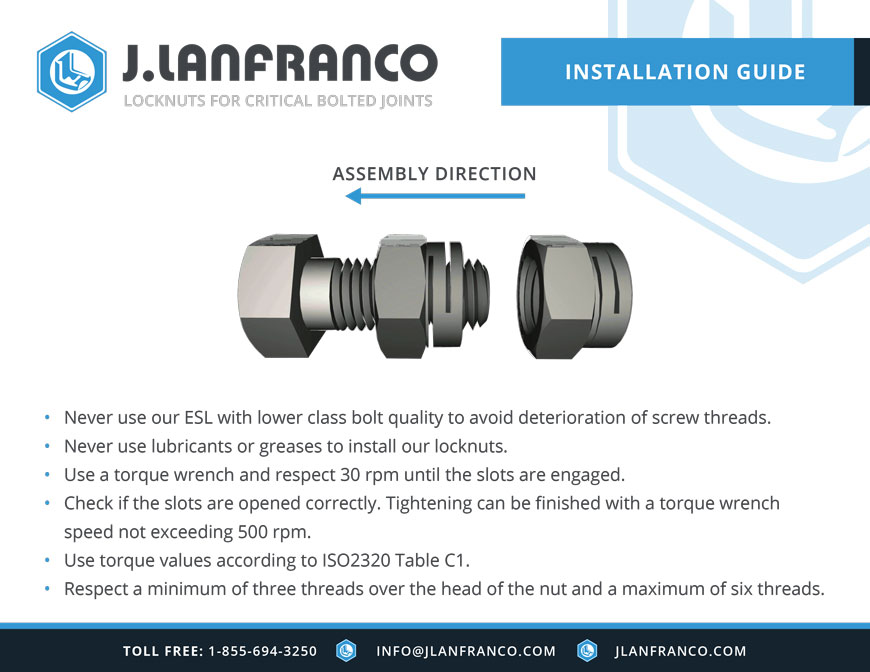Grade and class equivalencies
Some information on equivalency between metric- and imperial-based strength classes and grades is given in SAE J1199, sect.3.4 (Mechanical and Material Requirements for Metric Externally Threaded Steel Fasteners).
Metric fastener strength is indicated by a property class, which is equivalent to a strength grade for imperial threaded fasteners. These are the approximate equivalency grades to metric property classes for nuts and bolts supplied by J.Lanfranco:
- Class 8.8 is approximately equivalent to SAE J429 Grade 5, ASTM A449 & IFI 100/107 Gr.B (locknuts only)
- Class 10.9 is approximately equivalent to SAE J429 Grade 8 and ASTM A354 Grade BD & IFI 100/107 Gr.C (locknuts only)
- There’s no direct imperial equivalent to the metric 12.9 property class other than to specify material minimum tensile as 180ksi.
- Stainless steel A2-70 is approximately equivalent to AISI 304(L).
- Stainless steel A4-80 is approximately equivalent to AISI 316(L).
Markings
A material and mechanical certificate is your best assurance that safety-critical parts meet the requirements of the specified standards. A certificate confirms composition, hardness, proof load, and surface treatment. Be safe and get a certificate.
All bolts, nuts, and washers should be marked in accordance to their respective standards. In most cases, many washers don’t carry markings unless they are structural hardened washers, such as ASTM F436 (marking F436).
In the case of metric bolts and nuts, the property class will be indicated on the head of the fastener for bolts (eg: 8.8 , 10.9, 12.9) per ISO 898-1, and either the top or flats of a nut (depending on the size of the nut) per ISO 898-2.
Imperial threaded bolts will be marked per SAE J429 a majority of the time, but can also be marked using other structural bolting standards. Despite often having similar dimensions or material composition, these standards can be different once completely examined, each serving a different purpose. Always err on the side of caution and review the standard in question or speak with your fastener supplier for more information.
Imperial nuts are typically marked per SAE J995, while locknuts carry markings to IFI 100/107. It’s possible that a customer can request a prevailing torque per IFI 100/107 in combination with a specialty material. In this case, markings will typically follow that of the material specified, provided the locknut meets the minimum mechanical requirements. If unsure, ask what markings will be.
Most importantly: Get your certificates.
Certificates – whether they be of conformity, material test reports, hardness, prevailing torque or plating – are the most important insurance you have against non-confirming or counterfeit parts.
The most basic certificate should be a Certificate of Conformity, where the supplier clearly indicates the type of part and the standard it meets.
Following this, you can increase the level of certification you require. True, these additional levels of reporting may have some small costs associated with them, but overall it’s likely a small fee to avoid a failure or costly re-work. A small cost upfront will minimize the chances of a very big cost down the road.
In general, the best practices when designing critical bolted joints using locknuts are:
- Selection of the correct grade of raw material
- Tightening torque (Nm)
- Tension in the bolt (KN)
- Prevailing torque (Nm)
- Coefficient of friction
- Surface treatment
J.Lanfranco locknuts follow all industry-accepted best practices with one important difference: Always install your J.Lanfranco locknuts without the use of lubricants or anti-seize pastes. Because J.Lanfranco dual-slotted locknuts don’t seize up or damage bolt threads, the addition of any lubricant will alter the confirmed coefficient of friction and reduce the effectiveness of the locking feature.
See our installation video for a simple demonstration.
We don’t recommend using impact wrenches to install locknuts for a safety-rated bolted joint. That being said, a number of customers have used them successfully for years. The reality is that many work sites will only have impact wrenches on hand.
The key to consistently good installations is the use of deep sockets so that the locking slots have room to open as the nut is threaded on. Once the locking slots are engaged, finish at up to 500rpm. But, as material hardness increases and/or fine threads are used (as well as when using material that’s more prone to galling, like stainless steel), you should lower the rpm.
A majority of customers maintain their current torque values. However, for those looking to tighten up or re- evaluate their values, we are always ready to help. You can review our standard torque tables, calculated at 85% of bolt yield. Additionally, you can contact technical support to work out a torque table for your specific application.
Keep in mind: A torque value should always be in function of the assembly’s weakest material – especially when bolting weaker materials like composites. Careful attention must be taken when evaluating torque values.
We recommend that a minimum of two threads to a maximum of six threads protrude from the top of the nut. It’s important to know that surpassing six threads will constitute excessive rundown on the bolt. This can generate increased levels of heat and friction, and can result in galling.
Yes. Standard sockets, tools, and bolts are all that’s needed to properly install J.Lanfranco locknuts. However, the use of deep sockets is a best practice that will ensure the locking slots always have room to open and activate properly – even if running bolts further down.
Yes. Since J.Lanfranco makes all of its locknuts in France, we’re DFRAS compliant. Be sure to indicate on your RFQ that DFARS is required. We can also provide DFARS-compliant parts for metric bolts, washers, and some special imperial-threaded bolts.
We fabricate in both standard and fine metric thread pitches, UNC, UNF, and UNJC & UNJF. We also produce in British Whitworth and lesser known pitches like American Special (AS) upon request. If a thread pitch exists, we can do it.
